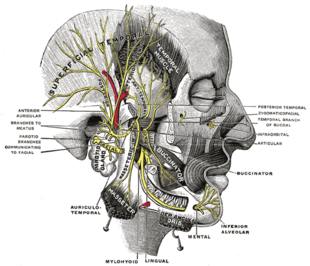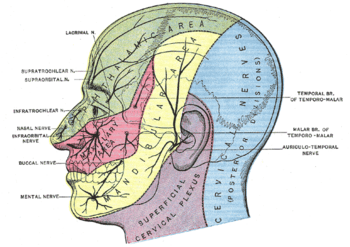Mandibular nerve
| Mandibular nerve | |
|---|---|
 Mandibular division of the trigeminal nerve. | |
 Mandibular division of trigeminal nerve, seen from the middle line. The small figure is an enlarged view of the otic ganglion. | |
| Details | |
| From | Trigeminal nerve |
| Identifiers | |
| Latin | Nervus mandibularis |
| MeSH | A08.800.800.120.760.500 |
| TA | A14.2.01.064 |
| FMA | 52996 |
The mandibular nerve (V3) is the largest of the three divisions of the trigeminal nerve, the fifth cranial nerve (CN V).
Structure
The large sensory root emerges from the lateral part of the trigeminal ganglion and exits the cranial cavity through the foramen ovale. The small motor root of the trigeminal nerve passes under the ganglion and through the foramen ovale to unite with the sensory root just outside the skull.
The mandibular nerve immediately passes between tensor veli palatini, which is medial, and lateral pterygoid, which is lateral, and gives off a meningeal branch (nervus spinosus) and the nerve to medial pterygoid from its medial side. The nerve then divides into a small anterior and large posterior trunk.
The anterior division gives off branches to the four main muscles of mastication and a buccal branch which is sensory to the cheek. The posterior division gives off three main sensory branches, the auriculotemporal, lingual and inferior alveolar nerves and motor fibres to supply mylohyoid and the anterior belly of the digastric muscle.
Branches
The mandibular nerve gives off the following branches:
- From the main trunk of the nerve (before the division)
- muscular branches, which are efferent nerves for the medial pterygoid, tensor tympani, and tensor veli palatini muscles (motor)[1]
- meningeal branch (a sensory nerve)
- From the anterior division
- masseteric nerve(motor)
- deep temporal nerves, anterior and posterior (motor)
- buccal nerve (a sensory nerve)
- lateral pterygoid nerve (motor)
- From the posterior division
- auriculotemporal nerve (a sensory nerve)
- lingual nerve (a sensory nerve)
- inferior alveolar nerve (a motor nerve and a sensory nerve - gives off the nerve to mylohyoid (a motor nerve, also supplies the anterior belly of digastric)
Supplies
The mandibular nerve innervates:
Anterior Division:
(Motor Innervation - Muscles of mastication)
(Sensory Innervation)
- Buccal nerve
- Inside of the Cheek (buccal mucosa)
Posterior Division
Lingual Split
(Sensory Innervation - NOT Taste)
- Anterior 2/3 of Tongue (mucous membrane)
Inferior Alveolar Split
(Motor Innervation)
(Sensory Innervation)
- Teeth and Mucoperiosteum of mandibular teeth
- Chin and Lower Lip
Auriculotemporal Split
See also
Additional images
 Dermatome distribution of the trigeminal nerve
Dermatome distribution of the trigeminal nerve The nerves of the scalp, face, and side of neck.
The nerves of the scalp, face, and side of neck.- Mandibular nerve
 Mandibular nerve
Mandibular nerve
References
- ↑ Illustrated Anatomy of the Head and Neck, Fehrenbach and Herring, Elsevier, 2012, page 181
External links
- MedEd at Loyola GrossAnatomy/h_n/cn/cn1/cnb3.htm
- Anatomy figure: 27:03-02 at Human Anatomy Online, SUNY Downstate Medical Center
- cranialnerves at The Anatomy Lesson by Wesley Norman (Georgetown University) (V)